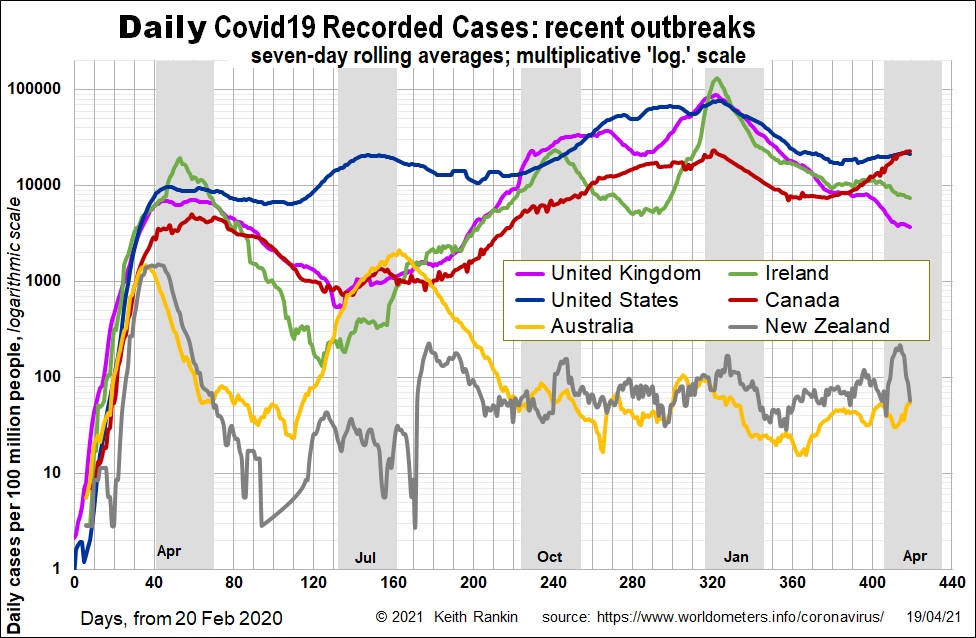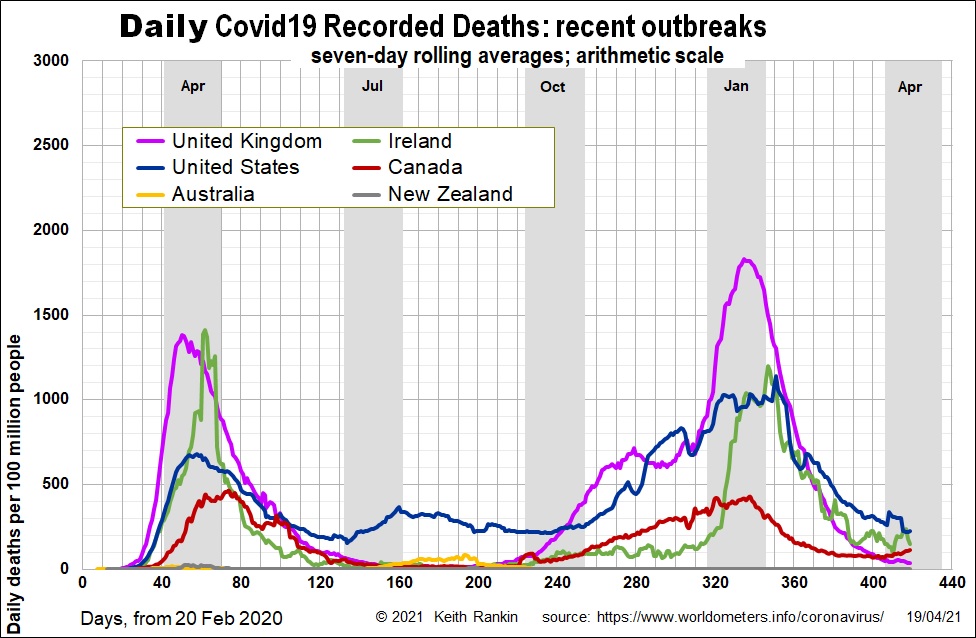Analysis by Keith Rankin – Covid-19: British Isles and Neo-European Countries

Canada has overtaken the United States in the last week, with over 200 daily cases per million people, with the worst growth zones being Ontario, British Columbia and Saskatchewan. However, the United States has some states that are worse, especially Michigan with around 900 daily cases per million people. In the United States, all the states north and east of Pennsylvania (especially those closest to New York) have recent Covid19 infection rates similar to Ontario. Further, it appears that, within these states and provinces, the problem is especially focussed on the metropolitan cities. Canada’s present outbreak began in early March.
By and large, these are the parts of the United States and Canada which have had both high levels of restrictions, high levels of compliance to restrictions, and – at least in these US states – high levels of vaccination. They are expecting a resumption of high levels of death, and of younger people.
It’s easy to say that the problem is new “more infectious” and “more lethal” variants. But why is it happening in these states and provinces which were most assiduous in self-protection? I suspect the problem is that the natural immunity to respiratory infections – taken as a broad class of disease – of young and middle-age adults has been compromised by the duration of physical distancing and by the widespread (often mandated) use of facemasks even at times of low levels of Covid19 transmission.
The problem here is that, if the new covid wave is only new more lethal strains of Covid, then the natural policy response is to have tighter and more prolonged restrictions, and to have facemasks more widely mandated even at times when other restrictions are lifted.
If I am correct, and the main problem is a loss of short-lived natural immunity, immunity that must be recharged by exposure to common colds and the like, then the prolonged use of non-emergency ‘cultural restrictions’ – such as facemasks – will aggravate the problem. Indeed, these restrictions will have aggravated the problem of reduced natural immunity already – hence the present phase of Covid19 – and that the pandemic will continue to accelerate as these restrictions intensify. The problem is, I sense, not that facemasks and physical distancing do not work, but that they work too well, blocking the mild respiratory infections as well as the deadly ones.
If we in New Zealand can secure annual influenza and covid vaccines, we may never suffer what Canadians are suffering right now. Further, annual covid vaccines will most likely protect us from future common colds. But we will become viral virgins if we ever find ourselves without a supply of the vaccines we will come to depend on.

Death rates are a better historical measure of the size of an outbreak of Covid19, because they do not depend as much on rates of community testing, as do case data. The initial outbreak a year ago holds up as being a big event, with death rates in the anglosphere countries high in large part because of the numbers of elderly people in aged care facilities.
In the northern hemisphere, the January death peak confirms that the most dangerous times are both winter, and times of great human mobility. These data suggest that our homes become our most dangerous environments when people who live elsewhere come to visit. Indeed we note the Thanksgiving bulge in United States’ covid death rates. In the United Kingdom we see problems arising from the movement of people – tourists and tertiary students – in September, and again from the school holidays in the last week of October.
The challenge for the United Kingdom will now be to ensure that its residents will have sufficient immunity to respiratory diseases to get their people through the next winter.








